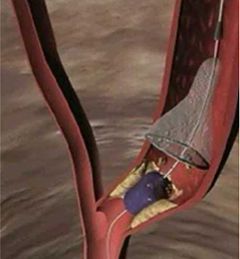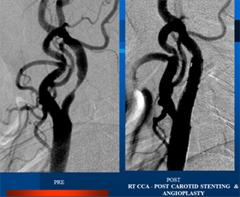| Stroke is third most common cause of death and disability. According to WHO Survey in 1990, out of 9.4 million deaths in India 6,19,000 were due to stroke. It has been estimated that approximately 20-30% of strokes may be caused by stenos is of carotid artery. WHO estimates for India that number of deaths from stroke to increase from 598000 in 2000 to 945000 in year 2020.
Patients and their families have in the past have felt hopelessness regarding these disorders. Even the medical community had limited treatment to offer in these cases. However, recently there have been many advances in the field of medicine with improvement in prevention and treatment of these disorders
Most of the strokes (approximately 75%) are ischemic (due to blockage of blood supply) in nature and large vessel disease accounts for approximately 40% of ischemic strokes. When the narrowing is beyond a degree, then inspite of medicines patient has high risk of stroke.
Patients with marked stenos is require revascularization which can be achieved by surgical (endarterectomy) or endovascular (angioplasty & stinting) means. Surgical revascularization is not possible in intracranial arteries and angioplasty/stinting are the option available for recanalization.
Neurovascular intervention/ Interventional Neuroradiology is a branch in which minimally invasive procedures of cerebrovascular disorders are performed. These procedures are carried by very thin catheters/wires etc. placed through leg vessels to the site of the abnormal vessels, followed by diagnostic and treatment procedures. This minimally invasive approach ensures minimal injury to normal brain, with less complications, better outcome and shorter hospital stay. With modern interventional (endovascular) techniques using 3D DSA and Flat panel technology, most of the carotid stenosis can be treated with reasonable safety.
Carotid artery stening is a minimally invasive procedure which is done under local anesthesia. With improvement of technology, these procedures have become quite safe. Filter protection devices are umbrella-shaped devices that are placed temporarily in the internal carotid artery beyond the site of stenos is during the procedure. These devices have small pores designed to exclude particulate debris embolization to cranial circulation during the procedure.
- The Carotid Revascularization Endartrectomy Versus Stenting Trial (CREST), funded by the National Institute of Neurological Disorders and Stroke is the largest randomized clinical trial comparing the surgical approach (carotid endartrectomy) to the non-surgical approach (carotid stenting) to prevent stroke among patients with and without symptoms.
- Carotid endartrectomy and carotid stenting proved similar in overall long-term safety and efficacy. The study also found that the age of the patient made a difference in outcome. At approximately age 69 and younger, stenting results were slightly better, with a larger benefit for stenting, the younger the age of the patient. Conversely, for patients older than 70, surgical results were slightly superior to stenting, with larger benefits for surgery, the older the age of the patient. However, it was seen in the trial that the results of carotid stenting kept improving with passing years
|




